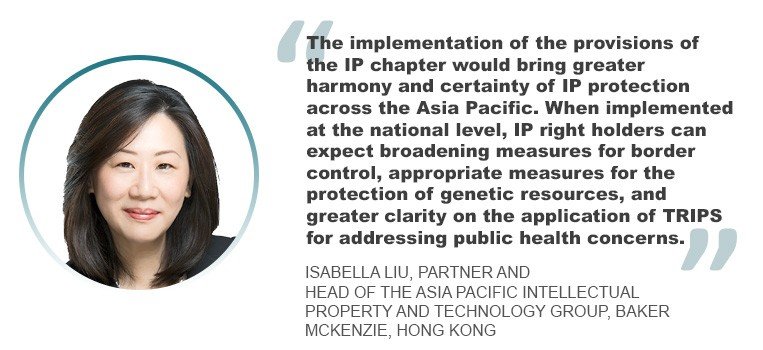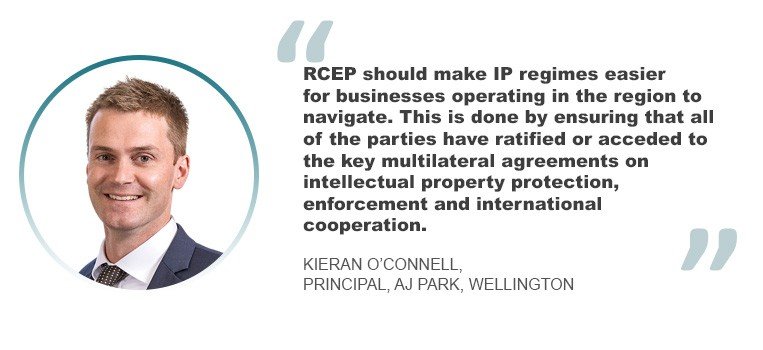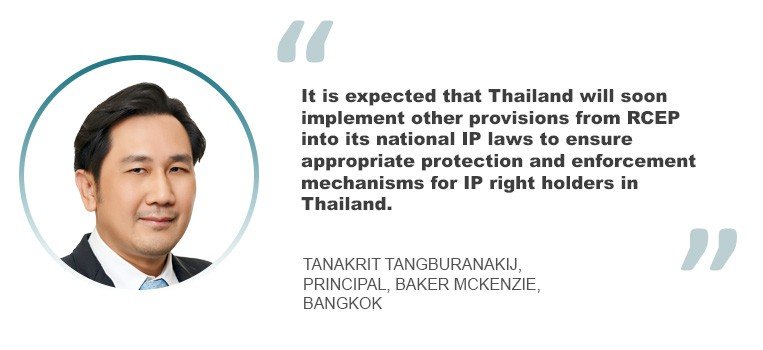RCEP and its Implications for the Asia-Pacific
31 March 2022

The Regional Comprehensive Economic Partnership (RCEP) Agreement, the world’s largest free trade agreement covering a large portion of Pacific nations, has finally come into force, after six ASEAN member states and four non-ASEAN signatories ratified the deal on January 1, 2022.
As with most free trade agreements, RCEP includes articles (in Chapter 11) to harmonize laws in relation to IP rights. Chapter 11 consists primarily of general provisions that are already fulfilled by a majority of RCEP signatories, while arranging for cooperation between signatories to assist in the implementation of newly acceded to treaties and expediting the prosecution of examined registered rights.
The RCEP agreement also aims to reduce impediments to trade and investment by creating a range of obligations relating to the creation, utilization, protection, and enforcement of intellectual property rights. Many of these obligations mirror and build upon those established by The Agreement on Trade-Related Aspects of Intellectual Property Rights (TRIPS), which all 15 signatory countries of RCEP have ratified. The IP chapter does, however, introduce the principle that intellectual property policy settings should maintain a balance between rights holders and the legitimate interests of users and the public interest.

With this ratification and this agreement, how then does it impact and influence IP in all regions? In Australia, the impact may be minimal as the country is already a signatory to all treaties that are mandatory under RCEP and has signed many trade agreements in the past that professed an interest, or investigation of, acceding to additionally treaties, notably the Hague Agreement in relation to Registered Designs.
“There is nothing to suggest that RCEP will result in action that has historically been outstanding,” says David Müller-Wiesner, a shareholder at GLMR in Sydney. “There are some subtleties in the language of RCEP that may be ventilated in Australian courts. For example, the treaty states that ‘patents shall be available for any invention, whether products or processes, in all fields of technology, provided that they are new, involve an inventive step, and are capable of industrial application.’ This is a contrast to Australia’s current approach to patentability, particularly in the field of software engineering, which (currently) stipulates that patentable inventions must be a technical solution to a technical problem, as opposed to a technical solution to a commercial problem.”
He adds that outside Australia, RCEP will hopefully lead to an increased uptake in examination expedition mechanisms across the signatories, allowing them to manage Asian portfolios more efficiently and, if desired, more swiftly.
“Additionally, the treaty encourages the uptake of grace period mechanisms, which are not yet widely adopted,” he says. “However, the adoption thereof might well be as enthusiastic as Australia’s adoption of the Hague Agreement.”

Increasing certainty in businesses and enforcing IP rights
Meanwhile, Kieran O’Connell, a principal at AJ Park in Wellington, says that the commitments made underthe agreement should help provide increased certainty for businesses when protecting and enforcing their intellectual property rights within the region. “RCEP should make IP regimes easier for businesses operating in the region to navigate,” he says. “This is done by ensuring that all of the parties have ratified or acceded to the key multilateral agreements on intellectual property protection, enforcement and international cooperation.”
He says that the facilitation of protection should also be enhanced by requiring the member countries to construct digital databases for intellectual property information and online platforms for the registration of intellectual property. Intellectual property rights are still required to be registered on a country-by-country basis, but these information and registration tools should make it easier for businesses to navigate the process.
“For exporters, the intellectual property provisions of the agreement should reduce uncertainty,” he says. “The harmonization and alignment of procedures and standards, and the facilitation of cooperation and enhancement of capacity building, should make it easier for businesses to protect and enforce their intellectual property rights through the RCEP region.”
He adds: “The RCEP agreement is relatively modest in its IP obligation, focused more on bringing the participating countries up to the obligations found in key multilateral agreements. The agreement does retain flexibility for member countries in the implementation of the obligations and highlights the need to maintain an appropriate level of balance between rights and obligations. The expectation is that the IP regimes of the participating countries will be improved over time, but this will still take time.”

According to Ren Jun Lim, a principal at Baker McKenzie Wong & Leow in Singapore, there are several changes brought to the existing IP regimes in the region. For instance, RCEP mandates the ratification of key multilateral agreements on IP for signatory countries and sets out specific transition periods for member states to follow through. “This ensures that all 15 RCEP countries adhere to the same standards for IP rules, increasing the ease of protection, enforcement and cross-border cooperation,” he says. “RCEP’s focus on the digitalization of IP rights is also reflected in its requirement for member states to provide publicly accessible online electronic databases for IP trademark applications and registrations. Enhanced access to IP databases will lower the barrier of entry into new markets by increasing the transparency of IP regimes in foreign countries.”
He adds that the enhanced access to IP information in other countries, coupled with the extension of protection to digital assets, will likely contribute to the promotion of technological innovation in the region. “Provisions detailing national obligations to provide effective enforcement measures and remedies will also boost IP rights holders’ confidence in expanding their market reach, resulting in an increase in trade volume and dissemination of information and technology,” he says. “However, one possible area of difficulty lies in the enforcement of IP rights. While RCEP obliges member states to ensure the availability of enforcement procedures, the ease of enforcement ultimately depends on the nature of the domestic enforcement and judicial authorities in each country. Further, businesses and IP rights owners must still take the initiative to notify the relevant authorities of any infringement of their rights.”

Impact on new IP laws
In general, the IP chapter is built on the framework of various existing multilateral agreements, including the TRIPS Agreement, the Berne Convention for the Protection of Literary and Artistic Works, the Paris Convention for the Protection of Industry Property as
well as other multilateral agreements administered by the World Intellectual Property Organization (WIPO). Most provisions in RCEP’s IP chapter are in the form of guiding broad principles. This chapter has its unique features, however, when compared to other IP-focused multilateral agreements. For example, it has dedicated a section on genetic resources, traditional knowledge, and folklore, as well as unfair competition.
“We do not expect a significant impact of the RECP IP chapter on parties that have already ratified or acceded to these multilateral agreements, such as China,” says Isabella Liu, who heads Baker McKenzie’s Asia Pacific intellectual property and technology group and is a partner in the firm’s Hong Kong office. “What would be interesting to see is how RCEP will impact the enforcement of the revised/new IP laws by parties that are already members to the mandatory sets of multilateral agreements, and the further alignment of IP protection at the regional level.”
She adds that, taking China as an example, China has already completed its amendments of the relevant IP laws to address the specific obligations under RCEP, including electronic rights management information (Article 11.15) under the revised PRC Copyright Law (effective June 1, 2021), as well as partial design (Article 11.49) under the amended PRC Patent Law (effective on June 1, 2021).

“Malaysia and Thailand are also amending their current IP laws to meet the obligations established under RCEP,” she says. “Given the importance of digital commerce in Asia Pacific, we also expect to see, per Chapter 11 further implementation and adoption of enforcement procedures and measures for tackling online counterfeits and civil and criminal remedies be more effectively extended for copyright and trademark infringement in the digital environment. As an illustration, under Chapter 11, the competent authorities should be entitled to inform the rightsholder details of the consignor, importer or consignee, descriptions, and quantities of goods and, if known, country of origin.”
With the 16 RCEP participating countries accounting for almost half of the world’s population, representing significant opportunities for businesses in the East Asia region, the parties include economies at very differing stages of economic development and with varying national legal systems. “The implementation of the provisions of the IP chapter in RCEP would bring greater harmony and certainty of IP protection across the Asia Pacific,” she says. “When implemented at the national level, IP right holders can, for example, expect broadening measures for border control, appropriate measures for the protection of genetic resources, and greater clarity on the application of the Agreement on Trade-Related Aspects of Intellectual Property Rights for addressing public health concerns.”
RCEP in Thailand
Thailand is in the process of amending the current IP related laws to cover certain commitments established under RCEP. This includes, among others:
• The draft Notification of the Ministry of Commerce (MOC) regarding Determination of Goods Infringing Trademark and/or Copyright to be Prohibited for Export, Import and Transit through the Kingdom, which was approved by the Thai Cabinet in January 2022. It aims to simplify and reaffirm the measures on prevention and suppression of counterfeit and pirated goods at the border by consolidating the current regulations, effective as of 1987 and 1993, which are separately incorporated in various legislations, into one all-encompassing legislation ensuring Thailand’s effective border measures pursuant to its commitments under Subsection 3 (Border Measures) of RCEP.
• The draft amendments to the Copyright Act, which incorporate the revised provisions regarding protection and effective remedies against the circumvention of Technological Protection Measures (reflecting Article 11.14 of RCEP).
• The draft amendments to the Patent Act, which incorporate 18-month publication (reflecting Article 11.44 of RCEP), partial design (reflecting Article 11.49 of RCEP), patent non-eligible subject matter, i.e. any inventions for commercial exploitation contrary to public order, morality, health and welfare or causing environmental damage as well as surgical methods (reflecting Article 11.36 of RCEP).

“It is expected that Thailand will soon implement other provisions from RCEP into its national IP laws to ensure appropriate protection and enforcement mechanisms for IP right holders in Thailand,” says Tanakrit Tangburanakij, a principal and member of the IPTech practice in Baker McKenzie in Bangkok. “Nonetheless, it will be interesting to see how Thailand can appropriately balance the exclusive rights of IP holders and the legitimate interests of users and the public, as envisaged by RCEP.”
He adds that many provisions of the IP chapter in RCEP are favourable to IP rights holders, despite the fact that it may take time for Thailand to fully implement the commitments set forth under RCEP. “The commitments provide increased certainty and enhanced IP protection/enforcement mechanisms for Thai IP rights holders when protecting and enforcing their IP rights in Thailand and in the RCEP region,” he says. “This will be accomplished by providing a regional framework and will subsequently bring benefits to IP rights holders in Thailand, including, among others:
• Ensuring that IP rights holders can utilize an electronic filing system of IP applications and access to IP databases online, instead of traditional means, which would encourage greater transparency and due process in the IP regimes in Thailand, as well as reducing regulatory and business compliance costs and times associated with those procedures;
• Standardizing protection and enforcement for IP rights holders in Thailand, extending to aspects like provisional and border measures under TRIPS, destruction of pirated and counterfeit products, and disposal of materials and implements predominantly used to create infringing goods. This gives trademark and/or copyright owners greater confidence to innovate and create by taking a tougher stance against pirated and counterfeit products and reduces the risk of further infringement;
• Broadening measures for border control, as well as providing effective/appropriate enforcement avenues and remedies to IP rights holders;
• Reinforcing the effective protection of technological protection measures used by copyright owners to prevent bypassing their works, and the protection of electronic rights management information (e.g., author identity, terms and conditions of use). Such measures are timely as businesses are becoming increasingly active in the digital realm; and
• Facilitating information sharing, cooperation and capacity building between Thailand and the other signatory countries to ensure high-quality IP rights of the holders are granted/registered, and they can be efficiently enforced. In terms of disadvantages or flaws in the IP provisions, his colleague, Praewpan Hinchiranan, a legal professional at the IPTech practice at Baker McKenzie in Bangkok, says “For the whole legal system with regard to IP protection, RCEP is not a significant challenge for Thailand since the commitments in RCEP are not that new, and are mainly built on the perspective of cooperation for mutual development rather than placing compulsory tasks on the immediate improvement of Thailand’s IP legal system. This may result in less attentiveness for regulatory harmonization on IP protection and slower diminutions in trade barricades in the region.
On the other hand, if Thailand decides to include all-embracing provisions governing the protection and enforcement of IP rights contained in RCEP, it may limit Thailand’s future policy flexibility to appropriately address any emerging IP-related issues if they arise.”

Harmonization and MSMEs
In the Philippines, according to Rowel S. Barba, director general of the Intellectual Property Office ofthe Philippines, the RCEP Agreement on IP is beneficial to the region in the following terms:
• Harmonization provides stability or predictability in terms of seeking protection and enforcing IP rights within RCEP.
• While the IP chapter recognizes the need for policy space and utilization of TRIPS flexibilities under the TRIPS Agreement, uniform substantive level of IP protection and enforcement in the region can be expected from all RCEP members.
• Applicants for IP protection, including micro, small and medium enterprises (MSMEs) will have the opportunity for 1) cost-effective modes/ routes via international filing systems such the Patent Cooperation Treaty; and 2) streamlined and aligned procedures such as those relating to electronic filing of applications and making relevant information available online.
• Enhanced cooperation and understanding among the RCEP members as any member have the right to 1) use the flexibilities under TRIPS to address or protect public health concerns, such as compulsory licensing of patented drugs and medicines; and 2) establish appropriate measures to protect genetic resources, traditional knowledge, and folklore (GRTKF). Furthermore, RCEP will foster cooperation between and among CMOs in the region, to the benefit of copyright and related rights owners and holders.
• As a show of solidarity in respect of social and human development, the blind, visually impaired or other print disabled within the region will benefit from the commitment of the members to accede to Marrakesh Treaty to Facilitate Access to Published Works for Persons Who Are Blind, Visually Impaired or Otherwise Print Disabled.
“It is underscored that the IP chapter of the RCEP Agreement has been described as one providing a balanced and inclusive approach to the protection and enforcement of IP rights in the region,” he says. “The concluded provisions are reflective of the conglomerate of interests of the members are aligned with the objectives of the IP chapter. During the eight years of negotiations, RCEP members were able to temper their respective ambitions, had hard work, creativity and patience to compromise and established landing zones for contentious issues, and firmed up their respective local mandates in confirming the commitments. In accepting, concluding, and signing the RCEP Agreement, members signify that the IP chapter is advantageous and serves their respective national interests. Thus, it is too early, say premature, to even consider that the IP chapter or a portion thereof, has disadvantages or flaws.”






